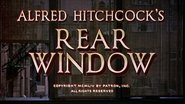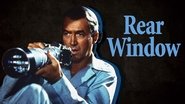gkeaton-15549
The movie Rear Window which was released in 1954 and directed by Alfred Hitchcock has proven to be a gripping and exciting movie that leads the viewer through a mystery. The main character L.B. Jeffries, played by James Steward, investigates a murder that he believed happened but has no real evidence to prove which he acts wonderfully in and makes the movie very exciting. This movie makes one evaluate the freedom that we have but also makes the viewer question is what L.B. Jeffries saw something that he should be concerned about and is he disrespecting others privacy.The main theme in the movie gives it an interesting feeling because of the general plot that is around what Jeffries sees when he looks out his window and spies on his neighbors. The way that the plot goes it suggests from the beginning that there is going to be a problem at some point because of the way that the dialog goes. From this when Jeffries is talking to Stella it seems clear that he is looking out the window too much and paying attention in a way to other people where he is seeing more than they may want to make public. At first, when Lisa Fermont comes to the apartment it seems that she is going to be able to talk some sense into Jeffries telling him that the observations that he is making are crazy, but then she ends up believing him and just contributing to his observations and obsession to see what his neighbors are doing. But, as the movie goes on we learn that the events he is seeing may not be so far-fetched and the evidence starts to build up suggesting that his neighbor Thorwald might have killed his wife. In the end, Doyle realizes that he was wrong and even though that Jeffries might have been going a little crazy he was still sure of what he saw in the window which was proven to not be in his imagination in the end.The movie gets even more suspicious when a detective friend of L.B. Jeffries, Thomas Doyle played by Wendell Corey, enters and initially doubts Jeffries because of circumstantial evidence. This is just the beginning of the character development for Doyle who starts doubting Jeffries then evolves over time to believe him more and eventually agree with accusing Thorwald of the murder. While Doyle may doubt Jeffries and his friends originally and want to have no part of the case, I believe that he eventually comes to realize that he knows Jeffries and that he may not be that crazy after all. This leads him to take another look at the case after Jeffries and Lisa Freemont find more evidence that suggests that the letter and things Doyle has found may not be true.The cinematography in the movie is very good and makes what is a small space feel very big and exciting with many different camera angles and tricks used. This is one of the largest factors that makes the movie exciting with the cuts from window to window and across the alley which show in an exciting way what is going on in all the different apartments. The cinematography is what makes the movie interesting because if it were shot in a different way the movie could very easily lose the viewers' attention. One of the most important and interesting shots in the movie is the opening shot where the camera pans through the alley setting the scene. This is very important because it really establishes the location where the events take place with a type of camera movement that we do not see many other times in the movie.Overall I would definitely recommend this movie to others because of the good cinematography, exciting storyline and good actors and actresses. I would give this movie an 8/10.
wth-60179
Rear Window
From an artistic perspective, I thought that this movie was very well done. The colors were vibrant but also showed the dullness that living in an urban environment can have. I also enjoyed the costumes and makeup of all the actors. I found that it reflected the time period well and accurately represented what a middle class person would dress and look like. I also enjoyed the sounds that were incorporated into the film. Throughout the film, birds could be heard or dogs barking and this gave a very open feel to the otherwise closed in feeling of being in a walled in apartment complex. Another very good aspect of the film was the quality of the actors. Throughout the movie, the actors do a very good job of "show don't tell." What I mean by this is that many scenes in the movie do not need the actors telling each other how they feel and it can be read on their faces. An example of this is when Grace comes to the realization that LB's theory that Lars killed his wife may have some truth behind it. You can see the change of expression on her face and without her even saying anything, the audience knows what she is thinking. The film had a very slow and relaxing feel at the beginning which I found interesting because it would be the opposite of what you might feel living in a downtown apartment. At the beginning of the film, the camera pans from apartment to apartment showing the daily lives of the people around LB. This gives us the feeling that we are actually looking through LB's eyes and feeling what he feels. I had a slight sense of loneliness when watching this because I felt that all of this was going on around me but I still felt distant and not a part of it all. I believe this is what Hitchcock was intending when filming this because it allows us to relate more to LB. During this scene, and in many other parts of the movie, it is as if LB is actually in a movie theater watching all of this unfold in front of him. In many scenes, such as the one where Grace breaks into Lars' house, LB must sit back helpless and watch it all take place as with the audience in the theater or the viewers at home. I found this very unique in that I have never experienced this perspective with any other movie I had seen. One thing about the film that can be seen as both a positive and a negative is the fact that there is a very long buildup from the beginning of the film to the climax. Although this can be seen as very important aspect of the story, I found it kind of boring at times and a little slow. There were times that I found myself spacing out and losing focus in the film. While I believe that a large portion of the film was slow, the last half hour of the movie had me on the edge of my seat. When Grace broke into the apartment and when Lars confronted LB were very well done. I felt the suspense that LB felt because we both felt that we were helpless and trapped in our seats.
coleboggan
I think that Alfred Hitchcock's rear window is a fantastic movie. I'd go as far as to say that it is one of the best thrillers I have ever seen. There are a few main aspects of the film that I would like to point out that sold me on this wonderful film: the framing and filming techniques, suspense building, and pacing of the film were all perfect, and made for an interesting, thrilling, and over-all exciting display of some of theater's finest filming techniques that will keep you on the edge of your seat until the credits roll.
First, the framing of the film was excellent. Upon first hearing the premise, that the entire movie takes place from one man's room, you might be hesitant. Such a boring, consistent setting couldn't possibly make for an interesting film. But within the first few minutes of starting, you find very quickly that these first impressions were very wrong. The film manages to build a complex, active, and very real world using just the room of main character, photographer L.B. "Jeff" Jeffries, and the view from his window. By cutting from shots of his apartment to the surrounding complex outside, the movie manages to make you think there's more to this film than just Jeff's living room. On top of this, the framing techniques used keep the film exciting. To start, you never see more than Jeff can through his window; this allows you to really connect with the characters, and theorize about the events going on at the same time as they do. We'll talk more about this under pacing, but the film always gives you just enough information to make you wonder what's really going on. Using what's not shown in frame as much as what is, Hitchcock manages to keep you glued to the screen throughout the movie.
This lasting interest is brought about just as much through the pacing and suspense of the film. While Jeff is looking out his window one day, he notices some suspicious behavior from one of his neighbors, and begins to think he has witnessed a murder. As the film continues, the evidence of this is given to you in bits and pieces. You only see half the story, and half to piece the puzzle together yourself, along with the main characters, who slowly start to believe Jeff's theories about his neighbor's actions. However, with every bit of evidence towards the crime, Jeff's detective friend strikes it down with a completely logical explanation, leading Jeff, and the audience along with him, to believe that he might be delusional. Every plot point in the film is spaced beautifully, so that every time you think you've figured it out, some new idea or suspicious act comes up and throws you completely off. As Jeff slowly convinces more people that he's witnessed a murder, there are always others who outright deny his ideas.
Another point related to pacing is the building of suspense. The movie manages to subtly build suspense as the movie progresses, resulting in a thrilling conclusion. One method it uses to do this is by confining our hero. Due to an accident at a race track, Jeff is confined to the wheelchair in his room with a broken leg. He is unable to leave his room, which is what results in him watching his neighbors through his rear window. The suspense continues to build as he watches helplessly as the events before him unfold. There's nothing he can do but watch it happen and try to make a convincing argument.
With all of these filming concepts combined, Alfred Hitchcock was able to produce one of the best thrillers of all time, certainly the best I've ever seen. It was intense, interesting, and kept me theorizing until the last second. With a great cast and exceptional production value, I would easily recommend this film to anyone looking for a classic with an exciting plot and interesting premise that will keep you engaged and entertained.


























